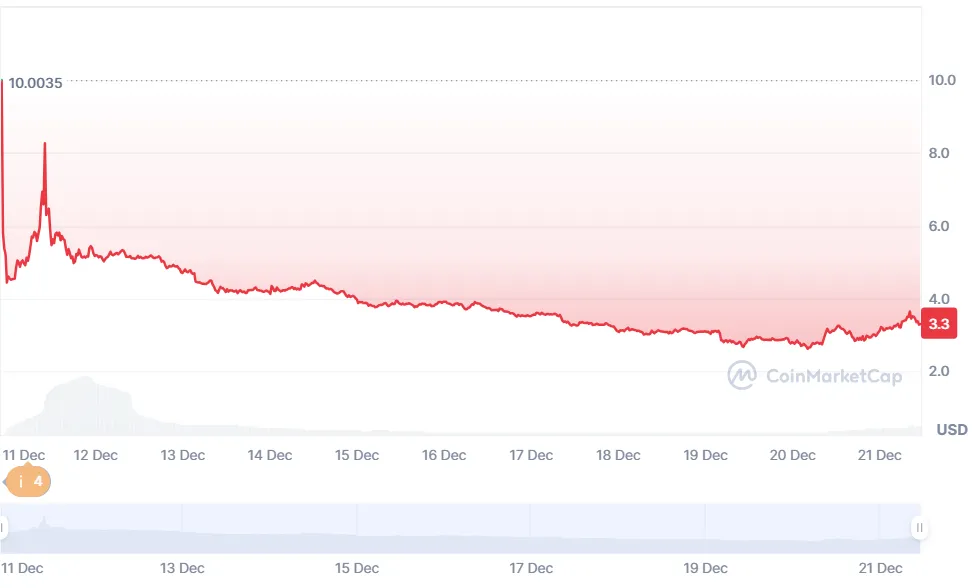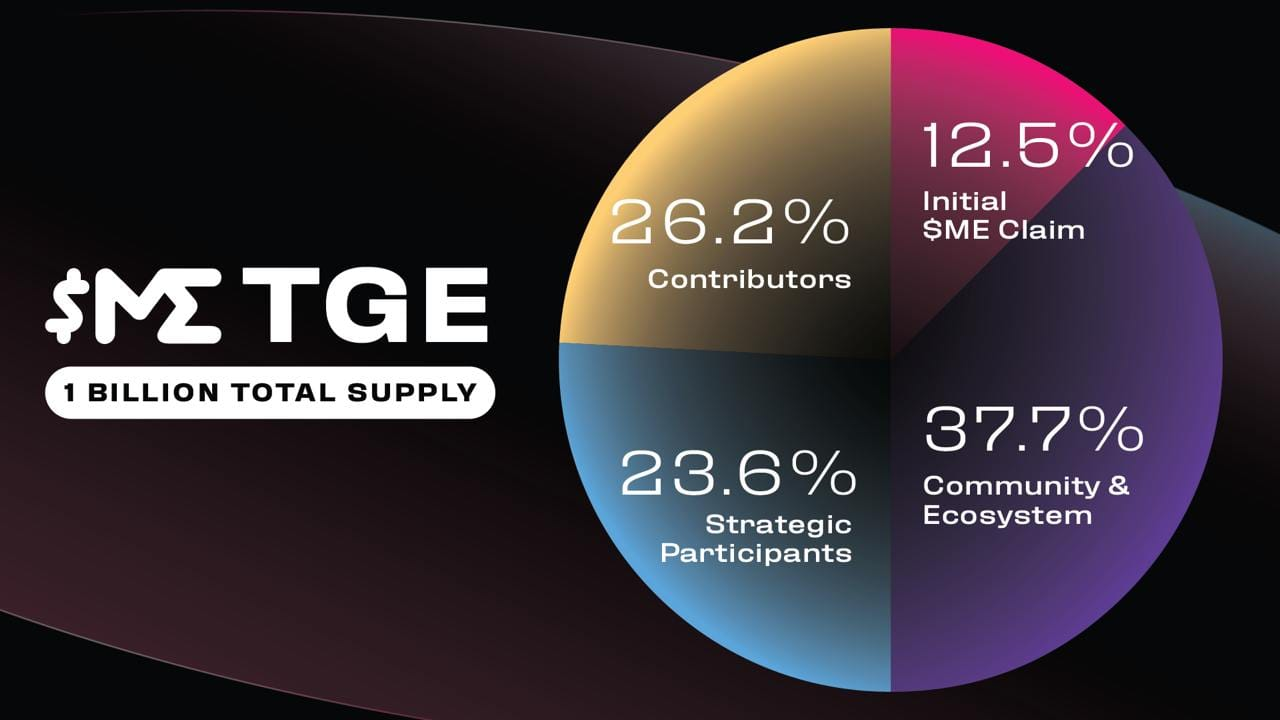Magic Eden after the currency issuance: opportunities and challenges in the multi-chain NFT market

Reprinted from panewslab
01/03/2025·3MWritten by: Riffi / Mat / Darl
Editor and proofreader: Nora
Source: WolfDAO
1. Project Overview
Magic Eden is a multi-chain supported non-fungible token (NFT) trading market. With its layout in multiple blockchain ecosystems such as Solana, Ethereum, Polygon and Bitcoin, it has risen rapidly and become a major player in 2024. One of the leading platforms in the market. Since its launch in September 2021, Magic Eden has rapidly expanded its market share through its cross-chain market and innovative features, especially after integrating Bitcoin Ordinals, becoming one of the important players in the field. This research aims to analyze its economic model, market position and future development direction, and evaluate its future growth potential.
2. Market performance and competition analysis
1. Market Sentiment and Token Performance

source:coinmarketcap
The ME token will be first released in August 2024, with a Initial Token Generation Event (TGE) scheduled for December. The initial market sentiment was relatively positive, but according to the current market trend, the price of the ME token failed to meet expectations, showing a trend of opening higher and moving lower. After falling below $3, the price rebounded to around $3.3, with a circulating market capitalization of $424 million and an FDV of $3.264 billion. One of the main reasons for this phenomenon is the downturn in the overall market, especially the weakness of the altcoin market. However, the continued decline in token prices lacks effective support and also reflects investors' cautious attitude towards the future prospects of the platform. This phenomenon shows that the NFT market and the altcoin market are generally sluggish, and investors remain on the sidelines regarding future growth.
2. Market share and competition

source:nftpluse
Magic Eden occupies a dominant position in Solana and the Bitcoin ecosystem, especially with a share of over 80% in the Bitcoin Ordinals and Runescape NFT markets. However, Magic Eden still faces huge competitive pressure from market giants on the Ethereum chain such as OpenSea and Blur. OpenSea is still the leader in the Ethereum market, and Blur has gained a competitive advantage in the high-end NFT market through low fees and frequent transactions.
Competitor analysis:
The main competitors on the market currently are OpenSea, Magic Eden and Tensor. Judging from user data, OpenSea and Magic Eden occupy a solid position in their respective ecosystems. OpenSea relies on its first-mover advantage to maintain its absolute dominance in the Ethereum main network and its second-layer network; Magic Eden occupies the vast majority of the Solana and Bitcoin ecosystems. The future competition between the two will mainly depend on the further development and user growth of both parties in their respective markets.
In the Solana market, Magic Eden's direct competitor is Tensor, but Tensor's shortcomings are quite obvious. First of all, Tensor’s user quality is relatively low, and many low-royalty transactions attract a large number of retail investors, resulting in low user loyalty and the average transaction price is much lower than other platforms.

source:nftpluse
- Main competitive platforms:
- OpenSea : Occupying a dominant position within the Ethereum ecosystem, relying on its strong brand effect and user base to maintain its leading position in the market.
- Blur : Focusing on low handling fees and high-frequency trading, it has attracted a large number of high-end NFT trading users, especially in the trading of high-value assets.
- Tensor : Mainly competes in the Solana market. Although it has achieved a certain market share on this chain, there is still a gap in user base and market depth compared with Magic Eden.
In the short term, Magic Eden's strong position in the Solana and Bitcoin markets will not be easily shaken, especially after TGE. Its increased funds and exposure may further expand its advantages. However, Magic Eden's biggest challenge remains to break through the monopoly of Blur and OpenSea in the Ethereum market. Although Bitcoin's Ordinals and Inscriptions once ushered in a craze, its market stability is far less than that of Ethereum. Even when the Ethereum NFT market is in the downturn, OpenSea and Blur still monopolize most blue-chip projects and have stronger community cohesion and market Recognition. As the saying goes, " Blur controls the large investors, and OS controls the retail investors. "
3. Market analysis summary

source:nftpluse
Although Bitcoin's ordinals and inscriptions once experienced a blowout, its market stability is far less than that of the ETH market. Even when the Ethereum NFT market is very sluggish, it still monopolizes several recognized big blue chips, community cohesion and recognition. are far ahead. On the other hand, although the prices of SOL and BTC, such as Bitcoin Frogs, once exceeded BAYC, they were short-lived and quickly faded away after the heat was over. If Magic Eden cannot bring out some evergreen projects in the future, the continued profitability of its protocol still remains to be seen.
3. Economic model and token economics analysis
1. Token issuance and distribution

The total supply of Magic Eden tokens ($ME) is 1 billion, which is planned to be gradually issued within 4 years. More than half of the tokens will be allocated to the community, and the specific allocation is as follows:
- Initial token claim (12.5%)
The initial airdrop portion will be fully unlocked at the Token Generation Event (TGE) and distributed to active users from ecosystems such as Bitcoin, Solana, and Ethereum. These users will become part of Magic Eden DAO. The unclaimed portion will be returned to $ME staking users as part of future community rewards.
-
Communities and Ecosystems (37.7%)
- Active user rewards (22.5%) : This part will be through Magic Eden’s reward program, mainly used to reward active users, and distributed through the platform’s mobile decentralized applications (dApp).
- Ecosystem Development (15.2%) : Includes long-term investments in ecosystems, funding to support creators and active advocates. This part of the funds will be provided through long-term agreements to ensure long-term stakeholder participation. In addition, 5% of ecological development funds will be allocated to the Magic Eden Foundation treasury for protocol support and liquidity provision.
-
Contributors (26.2%)
This part is mainly allocated to consultants, contractors and platform employees who provide support for the Magic Eden protocol and platform. In order to ensure long-term commitment, core contributors (accounting for more than 60% of the total contributor tokens) will be locked up within 18 months after TGE and gradually unlocked thereafter.
- Strategic partners (23.6%)
Strategic partners have provided important support for the development of the Magic Eden Foundation protocol. All strategic participants will lock up for at least 12 months after TGE, and token unlocking will follow the specified token release schedule.
Overall, there is no particularly innovative mechanism in this structure, and it mainly relies on conventional pledge transactions and community governance to promote user participation and ecological construction.
The initial release of tokens accounts for 12.5% of the total, which may put some selling pressure on the market. However, since unclaimed tokens will return to the pledge reward pool, and early investors usually prefer to wait and see, the short-term impact is relatively controllable. .
Mid-term contributor and strategic partner token unlocking may gradually increase market supply, and the market may experience greater volatility at this stage. If there is insufficient market demand at this time, the token price may come under downward pressure.
If Magic Eden can attract more users through ecological expansion and innovative features, its token selling pressure may be absorbed by strong demand.
2. Sustainability of economic models

source:nftpluse
Magic Eden’s profit model currently relies mainly on transaction fees and market revenue. The platform’s multi-chain strategy (especially the deep integration of Solana and Bitcoin) enables it to capture transaction volume from users on different chains. However, as market competition intensifies, especially in Ethereum and Layer-2 solutions, Magic Eden needs to diversify its profit model through innovative ecosystems and product features.
The trading revenue of the Magic Eden platform in the month before the currency was issued was US$2.8 million, with a market share of 45.4%, leading the second-ranked OpenSea by about US$600,000, and 9.3% of the revenue of the Blur platform that has issued coins (301,000). Times, this kind of revenue has remained strong after the airdrop was released. The recent 24h and 7d revenue were 91k and 1.1M respectively. Although the market share was surpassed by OpenSea due to the recent recovery of Ethereum blue chips, it still showed relatively strong profits. ability. Nonetheless, Magic Eden's price-to-earnings (PE) ratio is 50 based on its US$60 million in earnings over the past year, and its recent earnings decline indicates that its long-term profitability and market valuation are under certain pressure, although the Web3 project's market value assessment is relatively More complex than traditional markets, but it is also a very important reference indicator.
4. Challenges and future prospects
1. Market bottleneck
Although Magic Eden occupies a dominant position in Solana and the Bitcoin ecosystem, competition in the Ethereum ecosystem remains a huge challenge. The strong position of OpenSea and Blur in the Ethereum market puts Magic Eden under greater pressure in attracting Ethereum users.
2. Token unlocking and market selling pressure
The distribution structure of ME tokens is relatively aggressive, especially in the early stage when tokens are released less. A large number of unlocks in the later period may lead to an increase in market supply, thus putting pressure on token prices. This unlocking mechanism can lead to price volatility and increase market instability.
3. Insufficient innovation and ecological expansion
Currently, Magic Eden’s investment in innovative products and ecological construction is still insufficient. The platform needs to accelerate the innovation and expansion of the ecosystem, especially improvements in cross-chain support, differentiation of NFT market functions, and community governance.
in conclusion
Magic Eden has demonstrated a solid industry position with its market share and revenue capabilities in Solana and the Bitcoin ecosystem. However, its token $ME has faced multiple challenges since its issuance, including lack of market confidence, fierce competition, and unlocking selling pressure. In the competition with Blur and OpenSea, it is crucial to break through the bottleneck of the Ethereum market. In the future, the platform needs to strengthen the design of token economics, improve ecological construction and user stickiness, and lead the market through innovative products to continue to consolidate and expand its leading position.


 jinse
jinse
 chaincatcher
chaincatcher